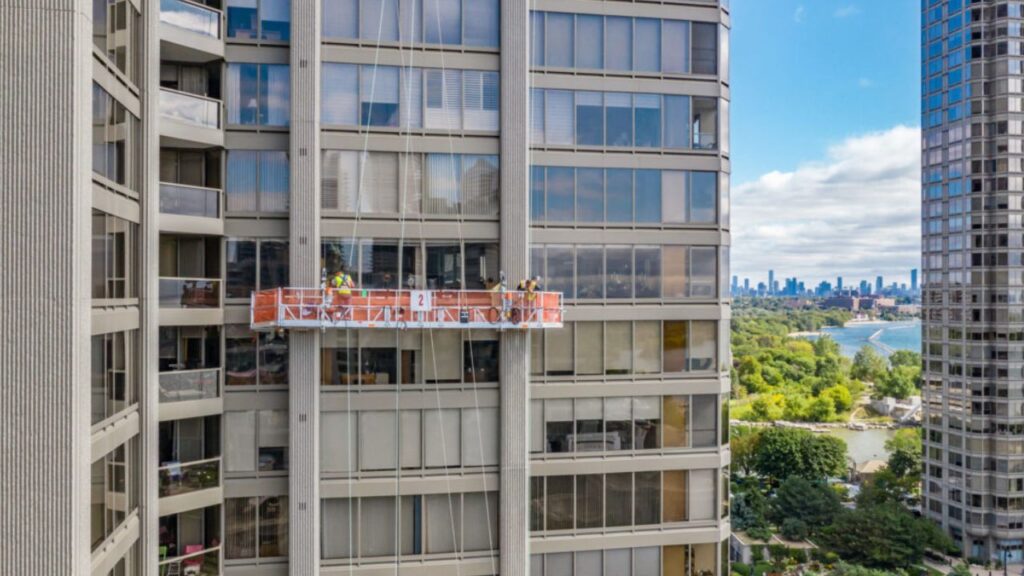Swing stage collapse leaves two window washers dangling high above Toronto Highrise.” Fortunately, two of them are alive after the incident, as reported by Matthew Bingley. (Global News, 2020)
This news hit people of Toronto on September 24, 2020. Such incidents of Swing Stage Failures make everyone realize how essential it is to comprehend and demonstrate the safe usage of a suspended work platform system, also known as a swing stage, before installing or using one.

Swing Stage Regulation and Guidelines
On January 1, 2017, an amendment to O. Reg 213/91 (Construction Projects), establishing O. Reg 242/16, came into force in Ontario that increases the responsibilities of employers whose workers use Suspended Work Platform Systems (Swing Stages), as well as other suspended access equipment (SAE).
The most significant changes in this amended legislation include:
More stringent equipment testing, maintenance and safety checks.
- Detailed plans for how swing stages are set up on projects;
- Better training for workers and supervisors who operate or inspect suspended access equipment;
- Stronger emphasis on written emergency procedures and rescue plans; and
- Precautions required to protect workers and others on the ground;
Responsibilities of Manager for fall protection on Swing Stage
Although the law supports the swing stage’s safe usage, the employer, contractor(s), supervisor(s), and users must use what they have learned in safety training and exhibit safe work practices continuously. Additionally, one should find a reliable rental firm or, if one owns the equipment, maintain it regularly to avoid any kind of swing stage failures.
Essential Guide to Swing Stage Safety
Any construction project must prioritize safety, and when using swing stages, careful attention to detail can make the difference between a smooth operation and a disastrous occurrence.
When using a swing stage, keep an eye out for the following important safety features:
- Platform Design: Build the platform to sustain the appropriate load, and remove any obstacles, such as ice or debris, that could cause accidents from the surface. Non-slip surfaces are essential for workers to keep their hold even in lousy weather.
- Fall Protection Systems: Install guardrails, mid-rails, and toe boards around the platform. To ensure suspension in the event of a platform or rigging failure, every worker must wear a full-body harness linked to a separate lifeline.
- Training and Competency: Only competent and trained personnel can operate swing stages. Training must cover the proper use of the equipment, safety precautions, and emergency protocols.
- Weather Considerations: Wind, rain, or snow can significantly impact a swing stage’s stability and functionality. Safety requires accurate weather forecasting and the implementation of backup strategies.
- Regular Inspections: A competent person must examine the swing stage for wear or damage that could jeopardize its integrity before each usage. Inspect every component of the system which includes the platform, support system, and fall protection system.
- Emergency Procedures: Emergency descending mechanisms and procedures must be in place to guarantee that workers can safely return to the ground if the swing stage fails. Regular drills must be carried out to ensure that every employee is comfortable with these protocols.
In conclusion, swing stages have improved safety and efficiency while revolutionising high-elevation work. However, using these devices requires constant attention to safety, as mistakes might have disastrous results. You can ensure that this equipment’s advantages are entirely realized by being familiar with the elements of a swing stage and implementing strict safety practices.
Ready to Learn More?
If you’re ready to learn more about safe operations at the workplace, look no further than our training courses at Act First Safety.
If you’re ready to book, then we’re ready to welcome you! Please contact our office at 416-283-7233. Here’s where to start your next step!




